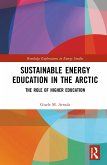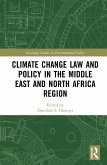Environmental and Technological Threats in the Arctic Region
Infrastructures, Geopolitics and Strategy
Herausgeber: Landriault, Mathieu; Delaunay, Michael; Vullierme, Magali
Environmental and Technological Threats in the Arctic Region
Infrastructures, Geopolitics and Strategy
Herausgeber: Landriault, Mathieu; Delaunay, Michael; Vullierme, Magali
- Gebundenes Buch
- Merkliste
- Auf die Merkliste
- Bewerten Bewerten
- Teilen
- Produkt teilen
- Produkterinnerung
- Produkterinnerung
Arctic subregions have undergone major structural changes in the past few decades. This book focuses rather on climate change and on the emergence of the digital economy and its infrastructures as two of the most fundamental threats for Arctic communities and inhabitants.
Andere Kunden interessierten sich auch für
![Climate Change and Technological Options Climate Change and Technological Options]() Konrad SoyezClimate Change and Technological Options76,99 €
Konrad SoyezClimate Change and Technological Options76,99 €![Climate Change and Technological Options Climate Change and Technological Options]() Konrad SoyezClimate Change and Technological Options76,99 €
Konrad SoyezClimate Change and Technological Options76,99 €![Technological Choices for Sustainability Technological Choices for Sustainability]() Technological Choices for Sustainability113,99 €
Technological Choices for Sustainability113,99 €![Sustainable Energy Education in the Arctic Sustainable Energy Education in the Arctic]() Gisele M. ArrudaSustainable Energy Education in the Arctic167,99 €
Gisele M. ArrudaSustainable Energy Education in the Arctic167,99 €![Climate Change Law and Policy in the Middle East and North Africa Region Climate Change Law and Policy in the Middle East and North Africa Region]() Climate Change Law and Policy in the Middle East and North Africa Region150,99 €
Climate Change Law and Policy in the Middle East and North Africa Region150,99 €![The Social Aspects of Environmental and Climate Change The Social Aspects of Environmental and Climate Change]() E. C. H. KeskitaloThe Social Aspects of Environmental and Climate Change167,99 €
E. C. H. KeskitaloThe Social Aspects of Environmental and Climate Change167,99 €![Sustainable Energy Education in the Arctic Sustainable Energy Education in the Arctic]() Gisele M. ArrudaSustainable Energy Education in the Arctic55,99 €
Gisele M. ArrudaSustainable Energy Education in the Arctic55,99 €-
-
-
Arctic subregions have undergone major structural changes in the past few decades. This book focuses rather on climate change and on the emergence of the digital economy and its infrastructures as two of the most fundamental threats for Arctic communities and inhabitants.
Produktdetails
- Produktdetails
- Verlag: Routledge
- Seitenzahl: 194
- Erscheinungstermin: 9. September 2025
- Englisch
- Abmessung: 240mm x 161mm x 15mm
- Gewicht: 461g
- ISBN-13: 9781041035855
- ISBN-10: 1041035853
- Artikelnr.: 74436466
- Herstellerkennzeichnung
- Libri GmbH
- Europaallee 1
- 36244 Bad Hersfeld
- gpsr@libri.de
- Verlag: Routledge
- Seitenzahl: 194
- Erscheinungstermin: 9. September 2025
- Englisch
- Abmessung: 240mm x 161mm x 15mm
- Gewicht: 461g
- ISBN-13: 9781041035855
- ISBN-10: 1041035853
- Artikelnr.: 74436466
- Herstellerkennzeichnung
- Libri GmbH
- Europaallee 1
- 36244 Bad Hersfeld
- gpsr@libri.de
Magali Vullierme has a PhD in political science. Her research aims to better understand multi-scalar security issues from the point of view of Indigenous and local populations in Arctic subregions. Magali Vullierme mobilizes the concept of human security and its seven dimensions in research analysing collaboration between the Canadian Inuit and the Canadian Armed Forces, health security in Nunavik, or risks linked to the acceleration of permafrost thaw for Indigenous peoples from the Sakha-Yakoutia Republic (Russia) and for Canadian infrastructures, both civilian and military. She is an associate researcher at the Observatoire de la Politique et la Sécurité de l'Arctique (OPSA, Canada) and at the Cultures, Environments, Arctic, Representations, Climate (CEARC, University of Versailles Saint-Quentin-en-Yvelines, France). Within the OPSA, Magali Vullierme co-directs the annual review L'Année Arctique. Michael Delaunay published a first article on submarine cable projects in the Arctic in 2013. He completed his PhD in political science at the University of Versailles Saint-Quentin-en-Yvelines, France, which focused on the role of telecommunications in the Canadian Arctic as a possible instrument of power for local populations and control for Canadian authorities. He is now a research associate at the Observatoire de la Politique et la Sécurité de l'Arctique (OPSA, Canada). He is also a research associate at the Cultures, Environments, Arctic, Representations, Climate at the University of Versailles Saint-Quentin-en-Yvelines. He is co-director of the annual review L'Année Arctique. He is currently working with the Danish Digital Infrastruktur Think Tank on the development of the digital infrastructure in the Arctic as a research coordinator of the research project Northern Clouds. In 2023, he published "Les Inuit connectés" with Presses de l'Université Laval. Mathieu Landriault is the director of the Observatoire de la politique et la sécurité de l'Arctique (OPSA, Canada) and an adjunct professor at École nationale d'administration publique. He also lectures at the School of Political Studies at the University of Ottawa and the School of Conflict Studies at Saint Paul University. He researches media and public opinion on Arctic security and sovereignty matters in addition to conducting research on the evolution of Arctic governance in recent years, especially in relation to subnational governments, the private sector, and non-governmental organizations.
Introduction SECTION 1 - Arctic (re)newed Environment ntroduction Section 1
Chapter 1 - Impacts of Permafrost Thaw in the Arctic: a (very) Brief
Introduction Chapter 2 - Subsea Sensing and Power Politics in the Arctic
Chapter 3 - The Canadian Armed Forces' Arctic Pan-Domain Command and
Control Cyber Attack Surface SECTION 2 - Arctic Infrastructures
Introduction Section 2 Chapter 4 - Canada's 2024 Defense Strategy: The Role
of Infrastructure and Climate Change in Arctic Security Chapter 5 - Impacts
of Climate Change on Transportation Infrastructures in Canada: Risks
Classification in Inuit Nunangat and Arctic Subregion Chapter 6 - The
Geopolitics of Quantum Sensors, Security, and the Mitigation of Climate
Change in the Arctic and High North SECTION 3 - Arctic Geopolitics and
Strategy Introduction Section 3 Chapter 7 - The Arctic as a New Strategic
Data Route for the European Union Chapter 8 - The Challenges of Resilience
and Sovereignty arising from the Dependence of Canadian Arctic Networks on
Satellites and US Infrastructures and Actors Chapter 9 - The Arctic Turn of
the Russian Cryptocurrency Mining Industry Chapter 10 - Russian Press
Agencies on the Arctic: Framing Western Military Initiatives Conclusion -
Mathieu Landriault
Chapter 1 - Impacts of Permafrost Thaw in the Arctic: a (very) Brief
Introduction Chapter 2 - Subsea Sensing and Power Politics in the Arctic
Chapter 3 - The Canadian Armed Forces' Arctic Pan-Domain Command and
Control Cyber Attack Surface SECTION 2 - Arctic Infrastructures
Introduction Section 2 Chapter 4 - Canada's 2024 Defense Strategy: The Role
of Infrastructure and Climate Change in Arctic Security Chapter 5 - Impacts
of Climate Change on Transportation Infrastructures in Canada: Risks
Classification in Inuit Nunangat and Arctic Subregion Chapter 6 - The
Geopolitics of Quantum Sensors, Security, and the Mitigation of Climate
Change in the Arctic and High North SECTION 3 - Arctic Geopolitics and
Strategy Introduction Section 3 Chapter 7 - The Arctic as a New Strategic
Data Route for the European Union Chapter 8 - The Challenges of Resilience
and Sovereignty arising from the Dependence of Canadian Arctic Networks on
Satellites and US Infrastructures and Actors Chapter 9 - The Arctic Turn of
the Russian Cryptocurrency Mining Industry Chapter 10 - Russian Press
Agencies on the Arctic: Framing Western Military Initiatives Conclusion -
Mathieu Landriault
Introduction SECTION 1 - Arctic (re)newed Environment ntroduction Section 1
Chapter 1 - Impacts of Permafrost Thaw in the Arctic: a (very) Brief
Introduction Chapter 2 - Subsea Sensing and Power Politics in the Arctic
Chapter 3 - The Canadian Armed Forces' Arctic Pan-Domain Command and
Control Cyber Attack Surface SECTION 2 - Arctic Infrastructures
Introduction Section 2 Chapter 4 - Canada's 2024 Defense Strategy: The Role
of Infrastructure and Climate Change in Arctic Security Chapter 5 - Impacts
of Climate Change on Transportation Infrastructures in Canada: Risks
Classification in Inuit Nunangat and Arctic Subregion Chapter 6 - The
Geopolitics of Quantum Sensors, Security, and the Mitigation of Climate
Change in the Arctic and High North SECTION 3 - Arctic Geopolitics and
Strategy Introduction Section 3 Chapter 7 - The Arctic as a New Strategic
Data Route for the European Union Chapter 8 - The Challenges of Resilience
and Sovereignty arising from the Dependence of Canadian Arctic Networks on
Satellites and US Infrastructures and Actors Chapter 9 - The Arctic Turn of
the Russian Cryptocurrency Mining Industry Chapter 10 - Russian Press
Agencies on the Arctic: Framing Western Military Initiatives Conclusion -
Mathieu Landriault
Chapter 1 - Impacts of Permafrost Thaw in the Arctic: a (very) Brief
Introduction Chapter 2 - Subsea Sensing and Power Politics in the Arctic
Chapter 3 - The Canadian Armed Forces' Arctic Pan-Domain Command and
Control Cyber Attack Surface SECTION 2 - Arctic Infrastructures
Introduction Section 2 Chapter 4 - Canada's 2024 Defense Strategy: The Role
of Infrastructure and Climate Change in Arctic Security Chapter 5 - Impacts
of Climate Change on Transportation Infrastructures in Canada: Risks
Classification in Inuit Nunangat and Arctic Subregion Chapter 6 - The
Geopolitics of Quantum Sensors, Security, and the Mitigation of Climate
Change in the Arctic and High North SECTION 3 - Arctic Geopolitics and
Strategy Introduction Section 3 Chapter 7 - The Arctic as a New Strategic
Data Route for the European Union Chapter 8 - The Challenges of Resilience
and Sovereignty arising from the Dependence of Canadian Arctic Networks on
Satellites and US Infrastructures and Actors Chapter 9 - The Arctic Turn of
the Russian Cryptocurrency Mining Industry Chapter 10 - Russian Press
Agencies on the Arctic: Framing Western Military Initiatives Conclusion -
Mathieu Landriault








